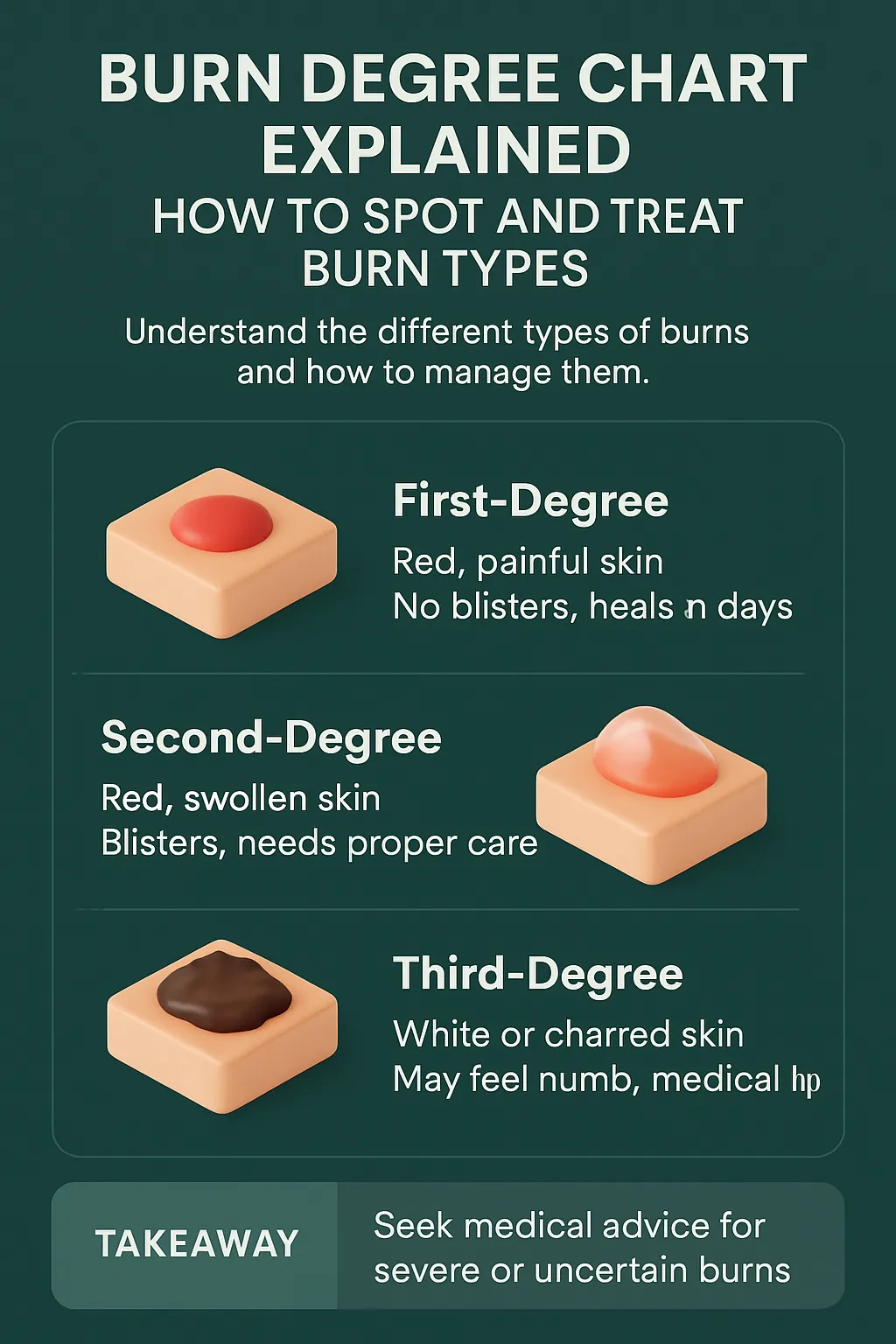Introduction: Why Recognizing Burn Severity Matters
Not all burns are created equal—and misjudging them can lead to serious complications. After years of working with patients and assessing burn injuries firsthand, one thing has become clear: understanding burn depth is key to proper healing. This guide isn’t just a clinical breakdown—it’s a practical, experience-based resource designed to help you recognize different burn types and respond effectively.
Whether you're a parent, caregiver, or first responder, learning how to spot and treat burns with the help of a burn degree chart can significantly improve outcomes and reduce recovery time.
Top Takeaways
- Burn severity matters — deeper burns need faster, more advanced care
- Pain can be misleading — third-degree burns may feel numb but are dangerous
- Act early — quick recognition prevents infection and speeds up healing
- Teach others — anyone can learn basic burn assessment with the right tools
How to Use a Burn Degree Chart to Identify Burn Severity
Burns are classified based on how deep they go into the skin:
First-Degree Burns
- Affect the outer layer (epidermis)
- Symptoms: Redness, dryness, mild pain (like sunburn)
- Healing: 3–7 days without scarring
Second-Degree Burns
- Reach the second layer (dermis)
- Symptoms: Blisters, swelling, moist appearance, sharp pain
- Healing: 2–3 weeks; risk of infection or scarring if untreated
Third-Degree Burns
- Destroy both skin layers and possibly underlying tissues
- Symptoms: White, leathery, or charred skin; often painless due to nerve damage
- Healing: Slow; typically requires medical treatment or skin grafts
A burn chart gives you visual clarity and helps you know when to seek medical care versus treating a burn at home.
Expert Insight
“In my years of working with burn patients, I’ve seen how a lack of understanding about burn severity delays care and worsens outcomes. A clear burn degree chart bridges that gap—empowering people to recognize danger signs early, respond appropriately, and avoid preventable complications.”
Case Study & Real-World Examples
Home Cook Misjudges Burn Severity
A woman spilled boiling water on her arm
Treated it as mild, used ice and cream
Blisters and swelling developed within 24 hours
Diagnosis: Second-degree burn, infected
Healing was delayed for weeks
Takeaway: A burn chart could’ve helped her act sooner and avoid complications.
A woman spilled boiling water on her arm
Treated it as mild, used ice and cream
Blisters and swelling developed within 24 hours
Diagnosis: Second-degree burn, infected
Healing was delayed for weeks
First Responders Rely on Burn Charts
EMS crews now carry laminated burn charts
In one case, a third-degree burn looked painless
Burn chart helped paramedics spot the severity fast
Result: Prompt transport and surgical care
Takeaway: Even professionals depend on simple visual tools to make the right call.
EMS crews now carry laminated burn charts
In one case, a third-degree burn looked painless
Burn chart helped paramedics spot the severity fast
Result: Prompt transport and surgical care
Parent Uses Burn Chart at Home
Child touched a hot pan
Parent referenced a burn chart
Determined it was first-degree
Used cool water and aloe
Full recovery in 3 days
Takeaway: Burn charts empower parents to treat minor burns with confidence.
Child touched a hot pan
Parent referenced a burn chart
Determined it was first-degree
Used cool water and aloe
Full recovery in 3 days
Supporting Statistics
Over 450,000 burn injuries require medical treatment annually in the U.S.
American Burn Association
73% of scald burns in children under 5 happen during daily activities at home
U.S. Fire Administration – FEMA
Third-degree burns may feel painless due to nerve damage
MedlinePlus – NIH
Over 450,000 burn injuries require medical treatment annually in the U.S.
American Burn Association
73% of scald burns in children under 5 happen during daily activities at home
U.S. Fire Administration – FEMA
Third-degree burns may feel painless due to nerve damage
MedlinePlus – NIH
Final Thought & Opinion: Burn Awareness Starts With Recognition
From years in emergency care and home consultations, I’ve learned that burn complications often begin with misjudgment—not the injury itself.
Why Charts Help:
Bridge the gap between uncertainty and action
Give fast visual cues for non-medical users
Boost confidence in emergency and everyday settings
You don’t need to be a doctor—you just need the right reference.
A burn degree chart can turn hesitation into life-saving decisions.
Bridge the gap between uncertainty and action
Give fast visual cues for non-medical users
Boost confidence in emergency and everyday settings
A burn degree chart can turn hesitation into life-saving decisions.
Next Steps: Take Action Now
Download a Burn Degree Chart
Print or save one for home, school, or the workplace
Know the Signs
First-degree: red, dry, mild pain
Second-degree: blisters, swelling, sharp pain
Third-degree: white or charred skin, little or no pain
Update Your First Aid Kit
Include aloe gel, gauze, burn ointment, and a burn chart
Know When to Seek Help
Third-degree burns
Burns on face, hands, feet, or genitals
Signs of infection (pus, fever, or spreading redness)
Share This Knowledge
Teach kids and caregivers how to recognize and respond
Send the chart to family and friends
Print or save one for home, school, or the workplace
First-degree: red, dry, mild pain
Second-degree: blisters, swelling, sharp pain
Third-degree: white or charred skin, little or no pain
Include aloe gel, gauze, burn ointment, and a burn chart
Third-degree burns
Burns on face, hands, feet, or genitals
Signs of infection (pus, fever, or spreading redness)
Teach kids and caregivers how to recognize and respond
Send the chart to family and friends
Frequently Asked Questions (FAQ)
What is a burn degree chart and why is it important?
It’s a visual tool to identify burn severity (first, second, third degree) based on symptoms like pain, color, and skin depth.
How can I tell the difference between burn degrees?
First: red, dry, mild pain
Second: blisters, swelling, wet
Third: white/charred, often painless
First: red, dry, mild pain
Second: blisters, swelling, wet
Third: white/charred, often painless





